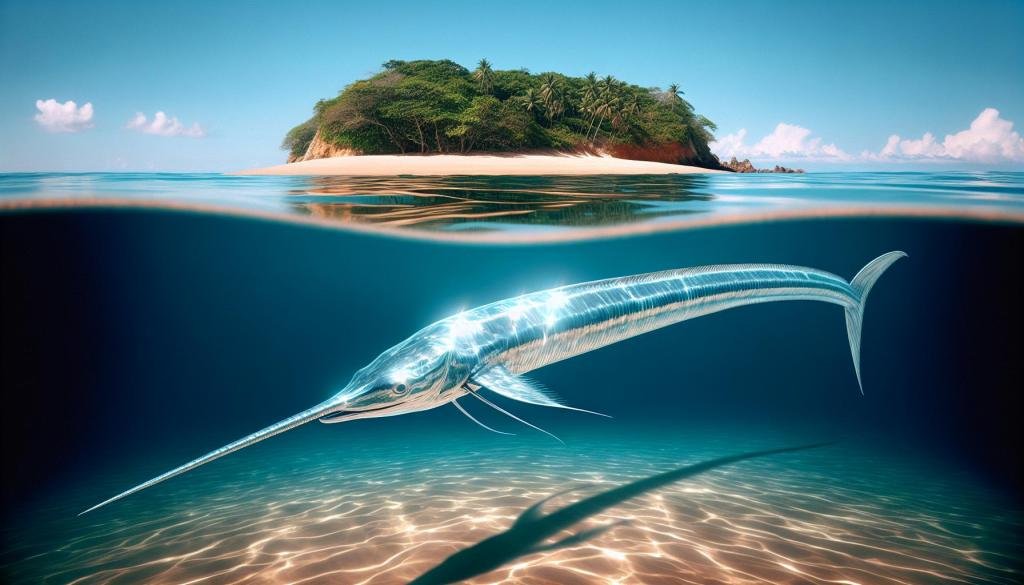
In an unexpected encounter that has sparked intrigue and curiosity, a shimmering oarfish, usually dwelling in the ocean’s depths, made a rare appearance near the surface on a beach in Mexico. These mysterious sea creatures, often referred to as “sea serpents” due to their long, slender bodies, provide unique insights into oceanic biodiversity and environmental health. As we explore this fascinating event, we will delve into the ecological significance of such sightings and their implications for understanding oceanic ecosystems.
Unveiling the Oarfish: A Rare Ocean Phenomenon
Oarfish sightings are a rare occurrence, drawing significant attention whenever they occur. Known scientifically as Regalecus glesne, oarfish are the longest bony fish in the world, sometimes stretching up to [36 feet](https://en.wikipedia.org/wiki/Oarfish) in length. Their usual habitat is in deep underwater regions ranging from 200 to 1,000 meters below the surface, making their appearance near beaches an unusual event. These creatures are often spotted more frequently following seismic activities. Scientists speculate that changes in oceanographic or environmental conditions could encourage oarfish to venture closer to the surface.
Echoes of Ancient Legends
Throughout history, oarfish have played a significant role in shaping marine folklore. Their serpentine movements through the sea and sudden appearances contributed to myths of sea monsters in various cultures. These legends, while fantastical, underscore a deeper connection between humans and marine life. Today’s sightings encourage further exploration of the behavioral patterns and habitats of oarfish, fostering an appreciation for the ocean’s mysteries that have intrigued civilizations for centuries.
Indicators of Ocean Health
The appearance of an oarfish near the surface can serve as a signal about the health of marine ecosystems. These mysterious creatures are sometimes sensitive to changes in their environment, and their appearance could hint at shifts within the ocean’s delicate systems. For instance, their migration may be influenced by changes in water temperature, pollution levels, or food availability. Monitoring such appearances can provide valuable data about the current state of marine biodiversity and guide efforts to address environmental challenges.
Environmental Implications and Research
Oarfish sightings have sparked interest in marine research and the need to understand our oceans better. The deep-sea habitats where these creatures typically reside are still largely unknown, presenting both a challenge and an opportunity for scientists. Research into oarfish behavior, sensory mechanisms, and interactions with their environment provides insights into the broader dynamics of marine ecosystems. Understanding these dynamics is crucial for developing strategies to protect the delicate balance of ocean life from threats such as [climate change](https://en.wikipedia.org/wiki/Climate_change) and human activity.
Linking Science and Sustainability
The unexpected discovery of the oarfish serves as a reminder of the intricate connections between marine biology and sustainability. The study of such rare events can inform conservation efforts, guiding policies aimed at preserving oceanic biodiversity. Through technological advancements and collaborative research, we can gather essential data on the impacts of environmental changes and work towards preserving these vital ecosystems for future generations. Encouraging young scientists to participate in marine research initiatives fosters a culture of innovation and environmental stewardship.
Guardians of the Ocean: A Collective Responsibility
By exploring sightings like this oarfish event, we can better grasp the interconnectedness of all life forms within our oceans. Conservation efforts must transcend national borders, calling for international cooperation in safeguarding marine life. Organizations dedicated to ocean conservation need support and engagement from public, private, and governmental sectors alike. By working together, we can implement sustainable practices that not only protect marine species like the oarfish but also ensure a healthy and vibrant oceanic ecosystem for generations to come.
The Future of Our Oceans
The rare surfacing of the oarfish near Mexico is more than just a natural oddity; it is an opportunity to reflect on our relationship with the oceans. Such events remind us of the ocean’s rich biodiversity and how much there is still to learn. As we continue to explore and understand marine life, we must remain committed to policies and practices that support conservation efforts. By prioritizing initiatives aimed at addressing environmental challenges, from pollution control to climate action, we can foster sustainable interactions with our oceans, ensuring their vitality for the long-term benefit of our planet.
The Wonder of Discovery
As we contemplate the mesmerizing appearance of the oarfish, we are reminded of the endless possibilities awaiting discovery beneath the ocean’s surface. These creatures symbolize both the challenges and opportunities associated with conserving our planet’s marine environments. Through continued education, awareness, and action, we have the power to make meaningful contributions to the protection of our oceans, celebrating each new discovery as a milestone in our collective journey toward sustainability.
The post Shimmering Oarfish Surfaces in Mexico: A Rare Peek into Ocean Mysteries appeared first on Green.org.














